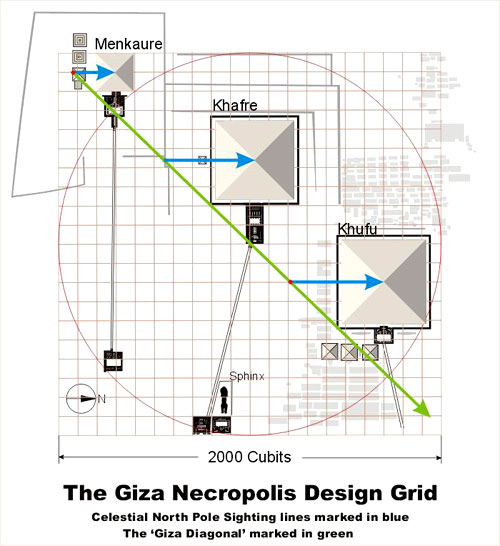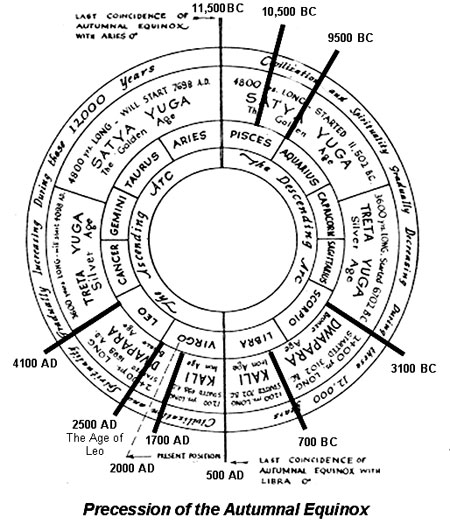|

by Norman Scherer
2004
from
CycleOfTime Website
Introduction
One night in early November 1983, Robert Bauval was camping
in the desert with some friends and family in Saudi Arabia.
Robert,
an engineer and amateur Egyptologist had recently been pre-occupied
with the reasons why the third and smallest of the three pyramids of
Giza was apparently not aligned along the same meridian as the two
larger pyramids.
For some reason that night he woke up at 3am and
gazed at the stars of the Orion constellation. After
awakening his friend who also shared his interest in astronomy and
had a passion for sailing, they discussed how to navigate using the
stars. His friend pointed out how to find the
star Sirius from the alignment of the three belt stars of
Orion which Robert had been looking at.
As an afterthought his
friend uttered these words,
Actually, the three stars of
Orion's Belt are not perfectly aligned. If you look
carefully you will see that the smallest of them, the one at the
top, is slightly offset to the east...1
and Robert Bauval's "Orion
Correlation" was born.
A True
Correlation?
While many people accept as fact that there is a correlation it has
quietly been shown not to be true by John Legon.
In his
methodical and precise article (also called The Orion Correlation),
Mr. Legon leaves no doubt that there most certainly is NOT a
correlation. He also makes a compelling case against one of the main
assertions in Bauval's theory, namely the association of Osiris
with the constellation of Orion.
You may also recall, that one of the foremost authorities on the
so-called "air shafts" of the Great Pyramid,
Rudolph Gantenbrink, flatly
states that these shafts could not possibly be... light or
"star shafts."
No! All the shafts bend, often several
times. In addition, all the shafts begin, at their lower ends, with
horizontal sections about 2 meters in length. So there is no way
light from any source could ever have penetrated from the outside
into either of the chambers. In several parts of the shafts, with
the exception of the lower southern one, we even found extreme angle
fluctuations. It is therefore ridiculous for anyone to claim that
the shafts could ever have pointed precisely to certain stars.
Given
the many angle fluctuations, the shafts could be construed to be
pointing at some 100 different stars, especially if construction of
the pyramid is gratuitously redated to match specific stellar
constellations.
While it is true that the smallest of the three pyramids at Giza,
known as Menkaura's, is offset of the south-west diagonal line
linking the two larger pyramids together, it is also true that the
south east corners of all three pyramids line up perfectly.
See
green diagonal line in illustration below:

Rate of
Precession
Yet the Orion Star Correlation theory limps on, seemingly
with a life all its own. So why this article?
Initially, when I
first read Bauval's books
The Orion Mystery and
The Message of the Sphinx, I was
very excited to read that the Orion Correlation alluded to a pyramid
construction date of circa 10,450BC. This was by associating the
precessional positions of the Constellation Orion (more specifically
the star Al Nitak) with the southern "air shaft" of the King's
Chamber circa 2450BC and a corresponding "perfect match" of Orion
with the Giza layout circa 10450BC2.
These precessional calculations
were done using the computer star simulation program Skyglobe 3.53.
I have used this program and while it may have been state of the art
in the mid 90's, it is obviously outclassed by much better star
simulation programs available today.
One thing it did do, however, was
precess thousands of years into the past (and future too) which
most programs today will not do. But this may be because the
accuracy of precessing star positions this far into the past
introduces more and more inaccuracies and error into the results
shown on the screen. No matter what software you use though, all of
them will show precession as occurring at a constant rate. As
explained in
Cycles of Precession article this
may not be correct. This is because our Sun may be part of a binary
star system.
In fact as summarized in the table 4 below it seems
there is better evidence for this as the cause of precession than
the conventional "wobble of the axis" theory that is virtually
accepted as fact.
Binary vs. standard model
comparisons
|
Proposed Binary Model
|
Current Model
|
|
Majority of star systems are binary
|
Minority of star systems
|
|
Curved path
of Sun through space explains the
Earthís changing orientation to inertial
space
|
No
significant curvature in Sunís path
requires Earthís changing orientation to
inertial space to be explained by
unproven complex theories (Occamís Razor
applies)
|
|
Sidereal and
solar year delta are natural result of
binary orbit
|
Sidereal and
solar year delta explanation conflicts
with sidereal and solar day explanations
|
|
Angular
momentum balances with dual star
|
Peculiar
distribution of angular momentum among
planets still unexplained
|
|
Sheer edge
of solar system expected, since mass is
separated between companion stars
|
Observed
sheer edge of solar system is unexpected
and not easily explained
|
|
Precession
accelerates past apoapsis
|
Lunisolar
precession should be constant but in
fact precession calculations are
continually altered
|
|
Precession
conforms to elliptical equation
|
Precession
should be relatively constant but is not
|
|
Curved path
of Sun explains apparent wobble without
causing rotational time problems, or
requiring equinoctial slippage
|
Rotational
wobble creates time paradox that
requires unexplained concurrent motions
|
|
Some long
cycle comet paths should be channeled by
dual mass
|
Comet paths
should be random but are not
|
The
Sirius Research Group is a website
devoted to the idea that our Sun is part of a binary system (with
Sirius) and they have the mathematical calculations to back it up.
On their website in a section where they publish letters received
from interested parties is the following post:
The co-author of "The Orion
Mystery", Mr. Adrian G. Gilbert, had made the following
statement in a letter to me on March 23, 1997:
Thank you for your long fax and subsequent letter, both of which
I have now studied. Whilst I find some of the explanation a
little technical, I am now sure you are right: Precession is a
mathematical con-trick, just like Ptolemy's epicycles. What we
see and interpret as the earth's 'wobble' is really the
effect produced by our sun going round the star Sirius.
This seems perfectly logical to me and I would have thought
would come as a great relief to astronomers, who have been
scratching their heads for decades trying to understand the
forces responsible for precession.
I wonder if Mr. Gilbert
understood the implications of what he said.
If he admits that
our Sun is in a binary orbit with another star it most likely is
an elliptical orbit. If that is true Kepler's Third Law would come
into play and the relative velocities of both stars would vary
throughout the cycle. What this implies is you cannot extrapolate
the current rate of precession back through time to achieve
positions of stars in our remote history.
As explained by Walter Cruttendan:
Visually, the new model is one of a
rotating object (the Earth) in an almost circular orbit
around a second object (the Sun), which in turn is an
elliptical orbit around a third object (the binary center of
mass of the Sun and a companion star). If the Earthís orbit and
the Sunís orbit are given, then the equations of classical
mechanics predict that the axis of rotation of the first
rotating object (the Earth) will precess (relative to inertial
space) at a rate dictated by the Sunís path around its binary
center of mass.
To an observer on Earth the first
objectís axis will appear to precess by 360 degrees in the same
amount of time it takes the second object to undergo a complete
orbit around the third object, independent of the masses and
distances involved. In this model the Earthís axis does not
really wobble, or change relative to the Sun, but it produces
the same observable now attributed to lunisolar precession -- a
precession of the equinox.
From this we conclude that
acceleration (and eventual deceleration) of the rate of
precession will depend on the eccentricity of the binary orbit.
From Keplerís Third Law, we know that all orbits are
elliptical and objects leaving apoapsis accelerate to
periapsis and then decelerate leaving periapsis.
Consequently, we now have an
explanation for why the precession rate is accelerating, and we
also have a logical reason for why the rate cannot be
extrapolated ad infinitum . Indeed, the most significant clue
that precession represents a binary orbit is its
universally recognized but until now, unexplained acceleration.5
If this theory is true then there is no
way for the "Orion Correlation" to be tenable.
The Message of
the Sphinx
In a follow-up book to The Orion Mystery, Robert Bauval
collaborated with Graham Hancock to write The Message of
the Sphinx. In this book they took the Orion star correlation
theory a step further by, among other things, extrapolating the
precessional rate back to the 10,500BC era and claiming that the
Sphinx, (with the body of a lion), was actually trying to convey
its date of carving by gazing at its astronomical equivalent in the
sky, namely the constellation of Leo which would have been,
"rising on the cross-quarter sunrise
between the winter solstice and the spring equinox. This sunrise
occurs at 14 degrees south of east, the point on the sunrise
targeted by the Khafre causeway." 6
Try as I might with my trusty little
Skyglobe program (which I assume they were still using) I could
never get Leo to rise at this time (which I assume was around Feb 4,
10500BC at 6:45am in Cairo).
I could only get the constellation Aries
rising. In any case, they were still using the current rate of
precession back through time which I think will be shown to be
inaccurate. It is interesting to note, however, that if you use
Yukteswar's model for precession (see
diagram below) you would see that the vernal equinox
precessed into 29į59' of Leo around 9500BC (when the autumnal
equinox was entering 29į59' Aquarius)
This is approximately the time
Plato (and Cayce) had for the final destruction of Atlantis.
9500BC
also marked the end of the Piscean Age (as marked by the Autumnal
Equinox) which rules all the oceans and supposedly the Atlantic
Ocean became the final resting place of Atlantis and signified the
end of an era. Perhaps this is the significance of the Sphinx-Leo
connection. The entering of the vernal equinox into Leo in 9500BC
marked the dawning of a new age which would not include the evils of
the final inhabitants of Atlantis.
A new civilization was begun in
Egypt. Maybe this is how they chose to commemorate this "new
beginning".

References
-
1 Robert Bauval and
Adrian Gilbert, The Orion Mystery: unlocking the secrets of
the Pyramids (New York: Crown Publishers, 1994), p. 115.
-
2 Ibid. p. 192.
-
3 Ibid.
-
4 Walter Cruttenden and
Vince Dayes , "Understanding Precession of the Equinox," New
Frontiers in Science (on-line version), (2003).
-
5 Ibid.
-
6 Graham Hancock and
Robert Bauval, The Message of the Sphinx (New York: Crown
Publishers, 1996), p. 260.
|


